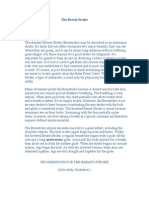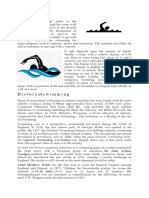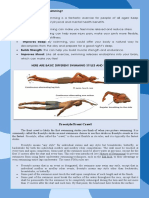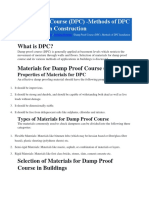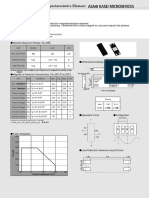0 ratings0% found this document useful (0 votes)
10 viewsSwimming KO
Swimming KO
Uploaded by
waitingttfThe document provides information about swimming skills, techniques, rules, and terminology for year 7 and 8 physical education. It includes descriptions and diagrams of front crawl, breaststroke, backstroke techniques as well as diving, treading water, and relay rules.
Copyright:
© All Rights Reserved
Available Formats
Download as DOCX, PDF, TXT or read online from Scribd
Swimming KO
Swimming KO
Uploaded by
waitingttf0 ratings0% found this document useful (0 votes)
10 views2 pagesThe document provides information about swimming skills, techniques, rules, and terminology for year 7 and 8 physical education. It includes descriptions and diagrams of front crawl, breaststroke, backstroke techniques as well as diving, treading water, and relay rules.
Original Title
Swimming-KO
Copyright
© © All Rights Reserved
Available Formats
DOCX, PDF, TXT or read online from Scribd
Share this document
Did you find this document useful?
Is this content inappropriate?
The document provides information about swimming skills, techniques, rules, and terminology for year 7 and 8 physical education. It includes descriptions and diagrams of front crawl, breaststroke, backstroke techniques as well as diving, treading water, and relay rules.
Copyright:
© All Rights Reserved
Available Formats
Download as DOCX, PDF, TXT or read online from Scribd
Download as docx, pdf, or txt
0 ratings0% found this document useful (0 votes)
10 views2 pagesSwimming KO
Swimming KO
Uploaded by
waitingttfThe document provides information about swimming skills, techniques, rules, and terminology for year 7 and 8 physical education. It includes descriptions and diagrams of front crawl, breaststroke, backstroke techniques as well as diving, treading water, and relay rules.
Copyright:
© All Rights Reserved
Available Formats
Download as DOCX, PDF, TXT or read online from Scribd
Download as docx, pdf, or txt
You are on page 1of 2
St Edmund Campion Physical Education Department – Knowledge organiser – Swimming year 7 and 8
Skills and Techniques Rules Glossary
Front crawl/freestyle: Front crawl Front crawl Streamline Freestyle
Back stroke Kick Pull Butterfly
Arms: (catch, pull, recovery): The finger tips lead the hand entry, Start by diving into the water. The Swimmer’s head must surface by Submerge Dive Tread-water Sculling
entering the water at a point in front of the head, between the the 15-meter mark. On the turn & finish some part of the swimmer Breast stroke Propulsion Medley
shoulder and centre line. The hand catches the water, palm down and must touch the wall at the turn and the finish. No pulling on the Synchronised Stream-lined Jump Breathe
then accelerates making a pull action, through an S shape pathway to lane lines, walking or pushing forward off the bottom of pool. You Buoyancy Body position Body tension
the hip. Recovery, The arm is taken back over the water in a pathway are not allowed to walk on or push off the bottom of the pool.
close to the body, with the head and near the water surface. Bilateral breathing Glide Float Water
Breaststroke Rules
Legs: Kicking action is on top of the water; kick from hip; knee slightly Pictures
bent; ankles relaxed; toes pointed. Usually 6 or 8 kicks per stroke Front Crawl arm action
Start by diving into the water. The swimmer is allowed one full arm
cycle.
pull (beyond hipline) and one kick while submerged at the start and
after turns; head must break the surface by the widest part of the
Breathing: There should be a breath out into the water as the arm 2nd stroke (before hands turn inward). The stroke cycle consists of
pulls through and the head rolls to the side ready to take a breath in. one arm pull and one kick in that order; the head must break water
Breathe inwards quickly as the arm recovers over the water surface surface at least once each cycle. Swimmer’s leg motions must be
and the face rolls back into the water as the hand enters. Each part of simultaneous; feet must be turned out in downward propulsive part Breast stroke leg kick
the stroke should complement each other whilst maintaining a of kick. No flutter or butterfly kick is allowed.
balanced and streamlined body position. All actions must be smooth
and continuous.
On the turn & finish a simultaneous two-hand touch is required. You
Breast stroke: 'pull, breathe, kick, glide' are not allowed two strokes or kicks underwater; alternating kick;
scissors kick; butterfly kick; arms not moving in the same horizontal
Legs: Breaststroke leg kick takes place under the water and begins plane; out-of-cycle or a one-hand touch.
with the legs in an extended position with feet together. The knees Back stroke leg kick
bend to bring the heels towards the butt and the feet flex into an Backstroke Rules
outward turned position at the same time. With the feet now turned
Start in the water, 2 hands on the bar and push off on your back.
outwards, they accelerate in a curved pathway, with the soles of the
You must remain on your back for the whole of the race. The head
feet exposed to the water to provide propulsion. The feet then snap must break the surface by the 15-meter mark. The swimmer must
together and the legs finish together to form a streamlined shape. remain on their back and may not be completely submerged except
Arms: The arms begin extended out front with palms facing
downwards. The arms then pull in a circular movement, outwards and at the touch and the finish. After the start you cannot be submerged
downwards, followed by a movement inwards and forwards. The past the 15M mark. You cannot pull on lane ropes or push off the
hands finish together with arms fully extended and elbows tucked in sides. You must touch the wall when you turn.
Relays
Breathing: Breathing inwards takes place every time the arms pull
back to allow the body to lift and the head to rise. Breathing outwards In a relay, four swimmers compete as a team. A swimmer may swim Backstroke breathing
occurs as the legs kick back and the arms extend forwards - think only once in a relay, and must swim one-fourth the total distance of
'blow your hands forwards'. the race. In a freestyle/front crawl relay, all swimmers swim
freestyle/front crawl. In a medley relay, each swimmer swims a
Back stroke: different stroke. In a medley relay the strokes must be swum in this
order: backstroke, breaststroke, butterfly, freestyle/front crawl.
Legs: Toes are pointed with ankles relaxed and the knees bend
slightly with each kick. The knee bend provides power on the upbeat Diving Front crawl breathing
phase of the kick, finishing as the toes just break the water surface.
Place your lead foot over the rim of the pool. If you're right-handed,
Arms: The hands enter the water little finger first, palm outwards with your lead foot will be your right foot, and if you're left-handed it will
the upper arm just brushing past the ear. The arm pulls through an S be your left foot. Standing start - Place your lead foot in front of
shape pathway, finishing at the hip, palm downwards. One arm begins your back foot, so your toes slightly jut over the pool. Your back foot
to pull as the other recovers over the water surface. Dive – Entry Dive - Preparation
should be on the ground, with your weight balanced equally over
your feet. Start from the side or starting block - start in a crouched
Breathing: Breathing should be regular and in time with the effort position, gripping the edge of the block with both your fingers and
phase of the stroke. your toes. As you start, push off from the side, raise your arms
above your head, with your elbows straight. Tuck your upper arms
Treading water: is where you move your limbs to keep your body against your ears. Hold your hands flat, with one palm resting over
afloat in a vertical position and your head above water. To scull/tread the back of your other hand. Push off and dive into the pool, with
water, you lift your arms sideways at shoulder level and then sweep your lead foot. Enter the water fingertips first. Keep your body
your hands forward and backward against the water. The pressure of Competitive dive start
straight as you dive, with your legs together and your toes pointed.
your arms and hands against the water creates some vertical lift that
keeps your body afloat. The leg kick also provides some lift that helps
you to keep your body afloat. To kick, you kick alternatively with each
leg forward then backward or complete breaststroke leg kick.
You might also like
- Biomechanics of BackstrokeDocument6 pagesBiomechanics of BackstrokebrettNo ratings yet
- Swimming PathfitDocument3 pagesSwimming Pathfitjasper pachingelNo ratings yet
- Biomechanics of FreestyleDocument7 pagesBiomechanics of FreestylebrettNo ratings yet
- Swimming QuizDocument5 pagesSwimming QuizKristine PanalNo ratings yet
- How To Swim: Learn to Swim Stronger, Faster & with Expert TechniqueFrom EverandHow To Swim: Learn to Swim Stronger, Faster & with Expert TechniqueRating: 3.5 out of 5 stars3.5/5 (2)
- History of The OttoDocument9 pagesHistory of The OttoAshish AgarwalNo ratings yet
- Theory of Survival StrokeDocument13 pagesTheory of Survival StrokeAnnie TheExplorerNo ratings yet
- Swimming Basic SkillsDocument15 pagesSwimming Basic SkillsJino Onij BolandoNo ratings yet
- Swimming SubjectDocument27 pagesSwimming SubjectLeandro Dick Paul TongbabanNo ratings yet
- PE Group 3 (BSA2)Document38 pagesPE Group 3 (BSA2)natalie clyde matesNo ratings yet
- Swimming 170411074755Document15 pagesSwimming 170411074755Michael BandalesNo ratings yet
- Masters Swimming NSW Coaching Drill Handbook: Anne Smyth (MSA and MSNSW Coach of The Year 2014)Document8 pagesMasters Swimming NSW Coaching Drill Handbook: Anne Smyth (MSA and MSNSW Coach of The Year 2014)Mazen OmarNo ratings yet
- Research Topic No. 2: Different Swimming Strokes and Styles: 1. Freestyle/Front CrawlDocument5 pagesResearch Topic No. 2: Different Swimming Strokes and Styles: 1. Freestyle/Front CrawlKrea kristalleteNo ratings yet
- P.E ReviewerDocument9 pagesP.E ReviewerPatricia Ann FigueroaNo ratings yet
- Backstroke or B-WPS OfficeDocument10 pagesBackstroke or B-WPS OfficeGNAAS-KNUST AYMNo ratings yet
- Term Paper About Swimming: Polytechnic University of The Philippines Sta. Mesa, ManilaDocument19 pagesTerm Paper About Swimming: Polytechnic University of The Philippines Sta. Mesa, ManilaJohn Mark LedesmaNo ratings yet
- MAC Freestyle Swimming DrillsDocument2 pagesMAC Freestyle Swimming DrillsEliseu PereiraNo ratings yet
- Swimming ReportDocument8 pagesSwimming ReportFranz Earl Niño AlbesaNo ratings yet
- Floating TechniquesDocument3 pagesFloating TechniquesEslaban, Betty MaeNo ratings yet
- Swimming StrokesDocument4 pagesSwimming StrokesarmanNo ratings yet
- The BreastStrokeDocument11 pagesThe BreastStrokeFrancisco Antonio Albuerne SanchezNo ratings yet
- Free Style Stroke (Swimming)Document30 pagesFree Style Stroke (Swimming)Marinelle TumanguilNo ratings yet
- Swiming StrokesDocument3 pagesSwiming StrokesYam MuhiNo ratings yet
- Swimming Front CrawlDocument96 pagesSwimming Front CrawlTrisha OrquiaNo ratings yet
- Swimming StylesDocument3 pagesSwimming StylesronalexisloveNo ratings yet
- SwimmingDocument3 pagesSwimmingDarcy Keith GuisdanNo ratings yet
- Pe3 Module 3 Activity (Submitted)Document2 pagesPe3 Module 3 Activity (Submitted)Julgan AnalizaNo ratings yet
- M1 - Basic Element in SwimmingDocument3 pagesM1 - Basic Element in SwimmingSeanNo ratings yet
- Module 5 Swimming PDFDocument11 pagesModule 5 Swimming PDFKarly De La CruzNo ratings yet
- Strokes in SwimmingDocument4 pagesStrokes in SwimmingJohn MerlinNo ratings yet
- Swimming G12 1Document52 pagesSwimming G12 1Danny MalonNo ratings yet
- Swimming - Tutorial 7Document1 pageSwimming - Tutorial 7annaNo ratings yet
- Intermediate Swimming Program: Ready, Set - Goal!Document19 pagesIntermediate Swimming Program: Ready, Set - Goal!orthomedNo ratings yet
- JakskslslalalalalaoalaDocument83 pagesJakskslslalalalalaoalaYeji Ylvira YamaraNo ratings yet
- Swimming StrokesDocument5 pagesSwimming StrokesRemy Gagtan GutierezNo ratings yet
- Sidestroke User, Purpose and Steps.Document3 pagesSidestroke User, Purpose and Steps.Cheveem Grace EmnaceNo ratings yet
- SWIMMING Ka GirlDocument11 pagesSWIMMING Ka GirlKristinelou Marie ReynaNo ratings yet
- Biomechanics of ButterflyDocument7 pagesBiomechanics of ButterflybrettNo ratings yet
- FLOATDocument9 pagesFLOATlimokillNo ratings yet
- 8 Different Swimming Styles and StrokesDocument3 pages8 Different Swimming Styles and Strokesgraceangelafful.tisNo ratings yet
- SWIMMINGDocument8 pagesSWIMMINGreme nelisNo ratings yet
- Strokes in SwimmingDocument3 pagesStrokes in SwimmingRenee MartinezNo ratings yet
- BackstrokeDocument42 pagesBackstrokeTuck Choy HorNo ratings yet
- BreaststrokeDocument3 pagesBreaststrokeznguyen555No ratings yet
- Prefi Lecture Notes - Pe 3 SwimmingDocument20 pagesPrefi Lecture Notes - Pe 3 SwimmingBethena SamanthaNo ratings yet
- Front Crawl TechniqueDocument15 pagesFront Crawl TechniqueI Gde Rama Putra YudaNo ratings yet
- Basic Swimming PDFDocument6 pagesBasic Swimming PDFQueenie AlotayaNo ratings yet
- Swimming Strokes ResearchDocument3 pagesSwimming Strokes ResearchfrancesNo ratings yet
- A. CrawlDocument5 pagesA. CrawlsakshiNo ratings yet
- SWIMMINGGGDocument16 pagesSWIMMINGGGjazzyNo ratings yet
- GRADE12 Lesson 3Document3 pagesGRADE12 Lesson 3Dolor GonzalesNo ratings yet
- PeDocument1 pagePeqweyo yhuNo ratings yet
- Basic Freestyle LectureDocument13 pagesBasic Freestyle LectureDo Van TienNo ratings yet
- Bsoa PeDocument3 pagesBsoa PeTino SalabsabNo ratings yet
- The Four Strokes The Four Competitive Swimming Strokes Are FreestyleDocument2 pagesThe Four Strokes The Four Competitive Swimming Strokes Are Freestylejasper pachingelNo ratings yet
- Swimming ProjectDocument6 pagesSwimming Projectrazelfaith tois bautistaNo ratings yet
- How To Swim The FreestyleDocument5 pagesHow To Swim The FreestyleGiovanie BaxtonNo ratings yet
- Frontcrawl TechniqueDocument31 pagesFrontcrawl Techniquejagwe ronnie lumalaNo ratings yet
- Pe3 Swimming Mod. 5& 6Document3 pagesPe3 Swimming Mod. 5& 6Paula Mae OngNo ratings yet
- SBL FHGC Muyo!tt 1Document15 pagesSBL FHGC Muyo!tt 1CRISTINE DELNo ratings yet
- Swimming Essentials: Swim Like an Olympian. Triathlon Swimming. Total Swimming Drills.From EverandSwimming Essentials: Swim Like an Olympian. Triathlon Swimming. Total Swimming Drills.Rating: 4 out of 5 stars4/5 (1)
- PE Game_ Crazy Ball - Health BeetDocument2 pagesPE Game_ Crazy Ball - Health BeetwaitingttfNo ratings yet
- Term 3 PE Net Games Y9Document2 pagesTerm 3 PE Net Games Y9waitingttfNo ratings yet
- Table Tennis KODocument2 pagesTable Tennis KOwaitingttfNo ratings yet
- Rugby KODocument1 pageRugby KOwaitingttfNo ratings yet
- Conceptualizing International MindednessDocument5 pagesConceptualizing International MindednesswaitingttfNo ratings yet
- Damp Proof Course (DPC) - Methods of DPC Installation in ConstructionDocument7 pagesDamp Proof Course (DPC) - Methods of DPC Installation in ConstructionAshrafNo ratings yet
- Chinese Herbs For LymphedemaDocument7 pagesChinese Herbs For Lymphedemanepretip100% (3)
- Research Paper On Optimum Addition of Glass Powder in For Replacement of CementDocument5 pagesResearch Paper On Optimum Addition of Glass Powder in For Replacement of CementJain SourabhNo ratings yet
- POSITIONING ANALYSIS Toyota Motor CorporationDocument6 pagesPOSITIONING ANALYSIS Toyota Motor Corporationbonnyjohn50% (2)
- Thesis Final VersionDocument49 pagesThesis Final VersionMohamed Omar IbrahimNo ratings yet
- Nutritional Management of Patients With Enterocutaneous Fistulas: Practice and ProgressionDocument12 pagesNutritional Management of Patients With Enterocutaneous Fistulas: Practice and ProgressionKevin Howser T. ViNo ratings yet
- HKPO09 Sol A PDFDocument4 pagesHKPO09 Sol A PDFlagostinhaNo ratings yet
- Agua Purificada PH EurDocument2 pagesAgua Purificada PH Eursarasa100% (1)
- Hermite Curve HandoutDocument2 pagesHermite Curve HandoutRicardo DíazNo ratings yet
- Homeowners Guide To Bathroom Remodeling 2022 - 03 - 31Document15 pagesHomeowners Guide To Bathroom Remodeling 2022 - 03 - 31Michel MatosNo ratings yet
- Dovpo Topside Dual User ManualDocument1 pageDovpo Topside Dual User ManualTeoNo ratings yet
- ED-sc 577353 2enDocument37 pagesED-sc 577353 2enpuh1967No ratings yet
- Basic Elderly HygieneDocument4 pagesBasic Elderly HygieneKiara Isabel Dela VegaNo ratings yet
- TransformersDocument61 pagesTransformersibraheem pashaNo ratings yet
- Ee Eipc3 5.englDocument10 pagesEe Eipc3 5.englZoran JankovNo ratings yet
- Introduction To Town Planning: Ar. Raghuteja Vemana School of ArchitectureDocument22 pagesIntroduction To Town Planning: Ar. Raghuteja Vemana School of ArchitecturecoolbuttNo ratings yet
- Insb Semiconductor Magnetoresistive Element: Shipped in Tray (225Pcs Per Pack)Document3 pagesInsb Semiconductor Magnetoresistive Element: Shipped in Tray (225Pcs Per Pack)Umar MahmudNo ratings yet
- Forward Look 2023 - Analysis and Research TeamDocument19 pagesForward Look 2023 - Analysis and Research TeamRoel PlmrsNo ratings yet
- 25 Important MCQS: Unit-4 (Part-3)Document27 pages25 Important MCQS: Unit-4 (Part-3)Vikash KushwahaNo ratings yet
- 02a Practice Test Set 1 - Paper 2FDocument20 pages02a Practice Test Set 1 - Paper 2Fnaz2youNo ratings yet
- Gaussian Elimination in 2DDocument3 pagesGaussian Elimination in 2Dhamster40No ratings yet
- Entendendo A Escasses Global de ChipsDocument29 pagesEntendendo A Escasses Global de ChipsCarlosNo ratings yet
- Microorganism Science Year 5Document5 pagesMicroorganism Science Year 5usemyknow.blogspot.com100% (1)
- 3D and Holographic ImagingDocument7 pages3D and Holographic ImagingViviNo ratings yet
- Table Rocks Curriculum: Pollination Partners ObjectiveDocument10 pagesTable Rocks Curriculum: Pollination Partners ObjectiveMAXIMO AROCUTIPA CATACORANo ratings yet
- Triacs MAC210 Series MAC210A Series: Silicon Bidirectional ThyristorsDocument5 pagesTriacs MAC210 Series MAC210A Series: Silicon Bidirectional ThyristorsIsrael Kuwait Valenzuela FloresNo ratings yet
- Regie Solomon 11-ABM-A1-2SJOSEDocument9 pagesRegie Solomon 11-ABM-A1-2SJOSEJeanelyn Mae PesimoNo ratings yet
- Medium Wave Broadcasts in India by All India RadioDocument3 pagesMedium Wave Broadcasts in India by All India RadioYash JadhavNo ratings yet
- Big Gear Inspection Is Booming: Oil Additives Can International CalculationDocument68 pagesBig Gear Inspection Is Booming: Oil Additives Can International CalculationmapalptsNo ratings yet




















